This article has mentions of products from one or more companies, and I may receive compensation if you purchase those products following reading my recommendations.
An Asscher cut diamond is perhaps the most distinctive of all the step cuts, immediately identifiable by its large open table, linear facets, and prismatic brilliance.
It is a diamond cut that is part of the renowned diamond dynasty, The Royal Asscher Diamond Company. With over 160 years of legacy, Royal Asscher is responsible for cutting some of the most famous diamonds in the world.
In 1902, Joseph Asscher designed the original Asscher cut. It was patented until the Second World War and became hugely popular in the years that followed.
Almost 100 years after Joseph designed the original Asscher cut, two other members from the Asscher family created the Royal Asscher cut. With access to new cutting technologies and polishing techniques, Edward and Joop Asscher worked on giving the Royal Asscher light performing qualities that had not been seen in any other step cut.
The geometric shapes that defined the Art-Deco era also translated into jewelry, with step cuts, including the Asscher cut, soaring in popularity. Today many designers continue to use Asscher cuts in designs that are reminiscent of the Art-Deco era. However, the Asscher cut has also found a firm place in modern jewelry settings and trends.
For the best round brilliant or princess cut diamonds on the market, check out A CUT ABOVE® by Whiteflash. For Asscher Cut Diamonds James Allen offers an amazing selection at a lower price however the Cut quality is not as high.
Asscher Cuts, Royal Asscher Cuts, and Square Emerald Diamonds
There is often confusion surrounding the Asscher cut which can make it difficult to make an informed choice for your jewelry, so here are the facts:
- There are two types of Asscher cut; the standard/original Asscher cut and the Royal Asscher cut.
- The standard Asscher cut features 58 facets. As there is no longer a patent on this cut, other diamond cutters have used the pattern. The standard Asscher cut is the same as a square emerald cut; people have continued to use Asscher as the universal name for a square emerald cut although the terms are interchangeable.
- The Royal Asscher cut has an extra break in the pavilion of the diamond and features 74 facets.
- A standard Asscher cut is square shaped. An emerald cut diamond is rectangular.
“Today the Asscher family name is often used as a commodity term for square-emerald cuts. It is obvious why companies want to use the world-renowned Asscher name.” – Royal Asscher Website
Cut
The GIA only offering a grading of polish and symmetry for Asscher cut diamonds; aim for Excellent or Very Good within these grading.
Beyond this, there are no set parameters for what makes a good Asscher cut diamond, although I have created a basic guideline that would be considered widely accepted by the industry, to assist your search.
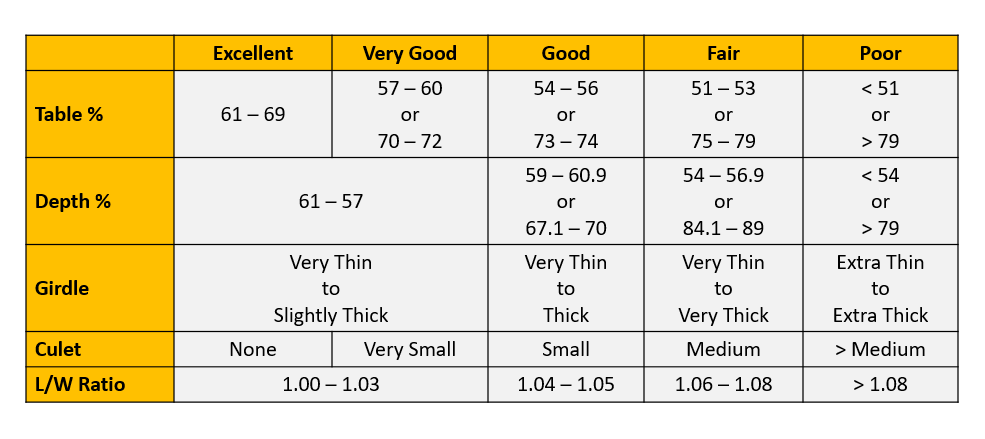
Unlike a brilliant cut, a step cut does not require the same depth as the light is not refracted in the same way. For this reason, I advise going lower on the total depth (around 60-68) as a shallower diamond will appear larger.
Remember that the price of a diamond is calculated by carat weight; as a step cut does not need to be deep, you will be getting a larger looking diamond at a good price if you go for a lower depth. A step cut that is deep will carry a higher carat weight with no aesthetic benefit to the stone.
A classic Asscher cut diamond will be a square and therefore have a length to width ratio of 1.0. However, the GIA will accept anything from 1.0 to 1.05 as a square shape so aim within this bracket.
While the purpose of a round brilliant is to sparkle, an Asscher cut is all about drawing the eye deep into the stone and creating rippling spirals of light. When it is perfectly cut, an Asscher diamond has a truly hypnotic effect, so it is worth taking the time to find one that sits within the advised parameters above.
Clarity
Step cuts are notoriously unforgiving when it comes to concealing inclusions. Brilliant cuts mask imperfections with sparkle and fire, while step cuts are all about presenting clean facet lines and a lure into the center of the stone. Their beauty quite literally lies in their transparency, and for this reason, it is essential to pay extra special care when choosing a clarity grade.
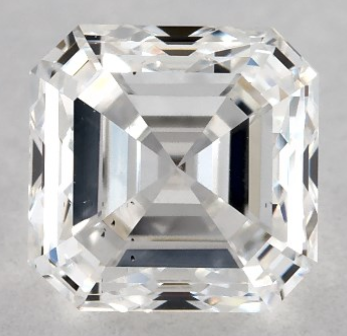
A brilliant cut diamond with a VS2 grading is unlikely to have any visible inclusions, however as this VS2 Asscher cut from James Allen shows inclusions are much easier to spot in a step cut.
This diamond is being viewed at a 20x magnification. Therefore it is unlikely that these inclusions would be immediately identifiable to the untrained eye. However, if we compare it to this beautifully clear VS2 then the importance of taking your time to view your diamond through high-res imaging becomes apparent.
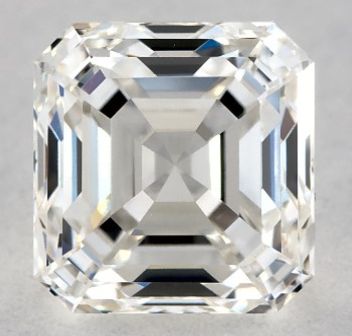
Not all VS2 grades will look the same, so be sure to view the stone and assess for yourself whether the inclusions will diminish the beauty of the diamond.
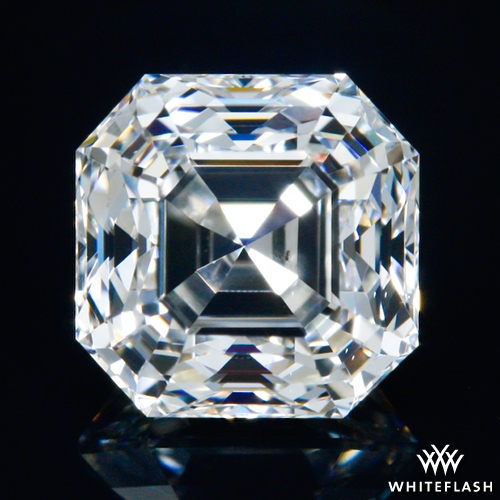
Although it is always my aim to recommend the best price point for your diamond selections, with a step cut it is worth going a grade higher where budget allows. Consider VS2 a minimum when it comes to choosing an Asscher cut diamond.
Color
Asscher diamonds are cut for clarity and luster; just a step away from the emerald cut diamond, these cuts enhance color rather than mask it. The emerald cut is, unsurprisingly, traditionally applied to emeralds and was created to intensify the color of the gemstone.
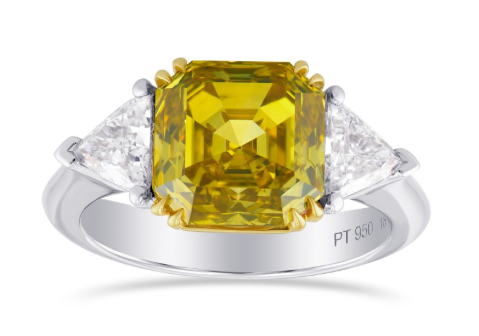
This fancy, deep yellow Asscher cut diamond from Leibish is a striking example of an Asscher cut being used to deepen the natural color of a gemstone. Ideal for those looking for a fancy colored diamond.
When looking at ‘white’ or colorless Asscher diamonds, it is important to choose the color grade with the same care as the clarity grade.
I would recommend a G-H in color. A G would be more suitable for a white metal setting or a ring with colorless side stones, while an H would be suitable for a warmer setting (such as yellow or rose gold) or a ring with colored gemstone accents.
And Finally…
There is something about an Asscher cut diamond that makes it unlike any other cut. Perhaps it is the beautiful balance between subtly twinkling facets and the cool, clean lines that draw you into the center of the stone. The harmony of softness and curve with the starkness of the geometric qualities. Whatever it is, the Asscher cut demands the utmost care and attention in its selection. I would recommend James Allen for their unrivaled diamond images as an opening to your search.
Asscher cut diamonds do not sparkle and scream for attention; they are a masterful, silent beauty that are sure to draw you in with their effortlessly hypnotic nature. Choose only the best.
